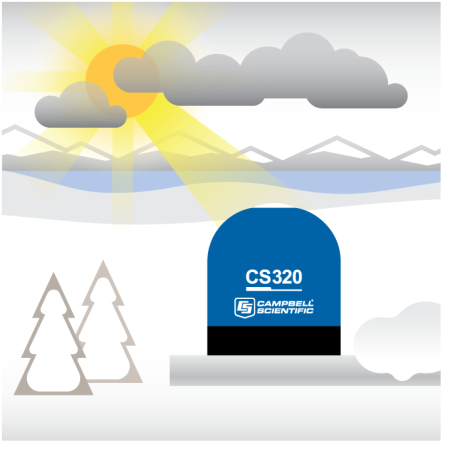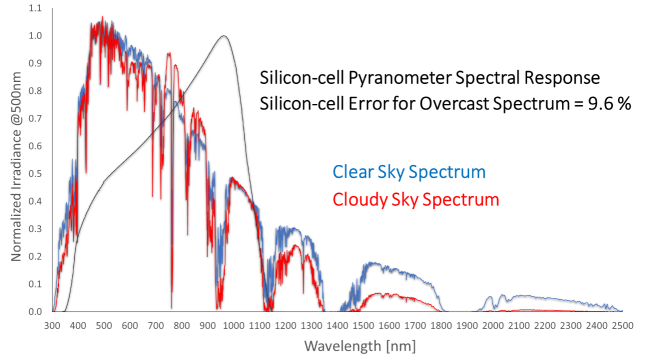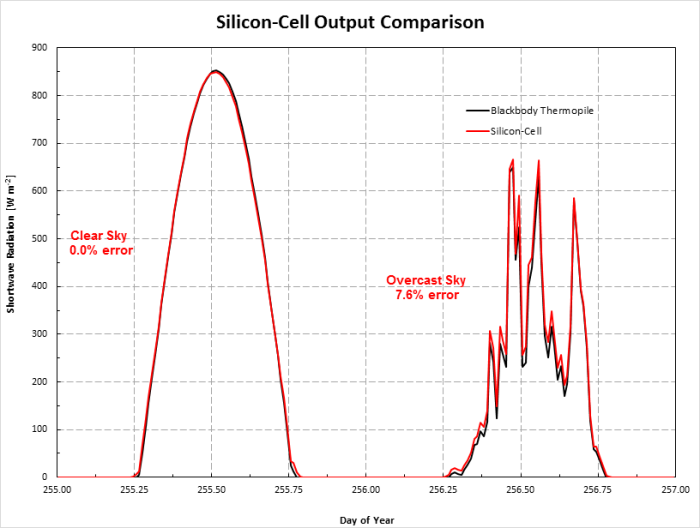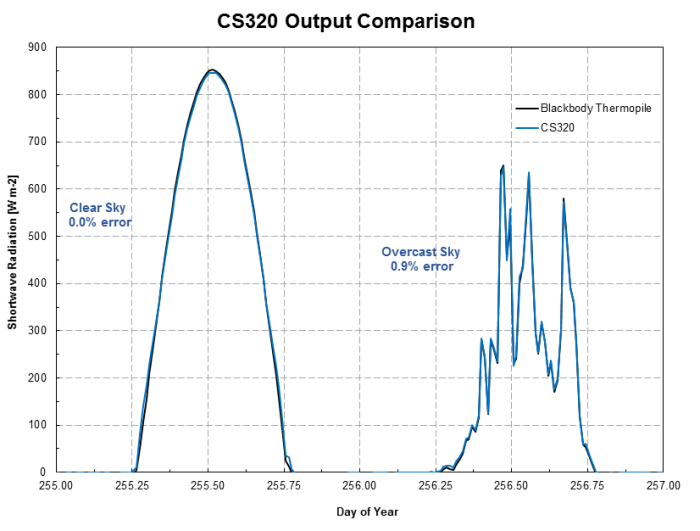更准确,简单地测量太阳
byChod Stephens.|更新时间:09/13/2017 |评论:4

为了帮助衡量太阳辐射的环境研究员改善他们的测量并简化了他们的生活,坎贝尔科学和专家组织开发了一个新的传感器。该新传感器结合了高端黑体热电滤波器和下端硅光电池粘膜仪的特点。这CS320 Digital Thermopile Pyranometeroffers a high level of accuracy, while keeping the cost competitive with silicon photocell designs.
Why Solar Radiation Matters
为环境研究人员获得准确测量太阳辐射是重要的,因为它可能对他们对自然界的理解产生重大影响。这种理解往往是与该研究的各种利益相关者沟通的关键。
例如,高估或低估的太阳辐射会影响科学家开发的作物水力解答中的估计蒸散,并由种植者使用业务。高估可能导致更多的水,而不是需要应用于作物,耗尽稀缺或昂贵的资源。低估可能导致农作物过度压力并且不会适当地生长。要么可能导致产量或作物质量差,影响种植者的底线,并影响我们的全球食物来源。
我们预计这一新传感器将最终通过帮助测量问题来使科学家,研究人员和人类受益。
准确性和天空条件
您是否知道您的Pyranometer的准确性可能会受到当前天空条件的显着影响?许多Pyranometers使用硅光电池元件,将太阳频谱分样,而不是直接测量整个光谱。这种技术在阳光灿烂的日子里运行良好,因为传感器在清晰的天空条件下校准,导致对总太阳辐射的准确预测。
不幸的是,这种技术还可以在多云或阴云密布条件下导致错误。如下图所示,多云条件会导致太阳频谱的变化。硅 - 细胞探测器不适合多云天空下的太阳光谱的变化,因为大多数这种变化发生在子采样范围之外。
Some measurement sites may rarely have clear skies, and the error caused by overcast conditions can be as great as a 15% overestimation of short-wave radiation by silicon-cell sensors. The graph above shows an instance when the spectral change on an overcast day resulted in an overestimation of approximately 10% when measured with a silicon-cell sensor.
Designed by Scientists for Scientists
Because we realize that environmental researchers are not fair-weather-only researchers, we designed the CS320 to measure incoming solar radiation and operate in all weather conditions—not just clear skies. The CS320 uses a high-grade blackbody thermopile sensing element that is sensitive to the full spectrum of solar radiation. The sensor’s internal circuitry converts the millivolt output to a solar energy value that has been individually calibrated using a secondary standard pyranometer traceable to the world radiation reference in Davos, Switzerland. While lower-cost silicon-cell pyranometers are being sold today, their accuracy specifications do not compare with the accuracy of the CS320 under all sky conditions.
为了说明精度的差异,下图在连续日期显示了太阳辐射的测量样本。第一个是一个明确的阳光灿烂的日子;第二天是阴天。用硅 - 细胞比率测量,在透明条件下,高端黑体传感器比较;但是,阴暗的日子上存在相当大的错误。CS320在同一连续天中测量了太阳辐射,并显示了阴沉条件下测量精度的显着提高。
Additionally, a couple of the CS320’s design features help the sensor continue making good measurements year-round. The dome-shaped head of the CS320 is designed to be self-cleaning for maintenance-free operation. This sensor also has a built-in heater that is controlled via an SDI-12 command. This low-power heater keeps the diffuser free of dew, frost, snow, and ice.
Simple to Implement, Operate, and Maintain
CS320数字热电堆仪的各种功能旨在简化太阳辐射测量应用,同时以合理的价格为您提供一流的性能。
这digital interface (SDI-12) of the CS320 simplifies the programming and wiring of the sensor to any current Campbell Scientific data logger. Because the analog-to-digital converter is placed inside the sensor, the calibration coefficients are also programmed inside the sensor. This eliminates the need to change your data logger program for each CS320 sensor being used. Also, with the detachable cable, you can quickly swap out CS320 sensors when they are sent in for calibration.
这digital CS320 sensor provides useful data beyond the solar radiation measurement. A built-in temperature sensor on the measurement board provides a reference for temperature corrections and allows for improved heater control. In addition, each sensor has an embedded 3-D tilt sensor that allows it to report the x, y, and z coordinates for orientation. This determines how level the sensor is and if the senor has moved. This diagnostic tool is important, as pyranometers must remain level to produce accurate global solar radiation data.
结论
CS320旨在改善硅 - 细胞焦点计的全球太阳辐射测量,但保持相同的成本。这种数字热电堆仪适用于从环境研究到农业到大型Mesoscale天气网络(Mesonets)的应用。If you have any questions about the CS320, please post them below.




















 Chod Stephens是Campbell Scientific,Inc。在Campbell Scientifial,Inc.的技术产品经理。在坎贝尔工万博matex网页登录作之前,Chod被聘请为犹他州州立大学的研究技师,他还获得了土壤物理学的硕士学位。
Chod Stephens是Campbell Scientific,Inc。在Campbell Scientifial,Inc.的技术产品经理。在坎贝尔工万博matex网页登录作之前,Chod被聘请为犹他州州立大学的研究技师,他还获得了土壤物理学的硕士学位。
注释
GAG|09/14/2017 at 08:41 PM
你好,chod,
I am waiting for a Solar radiation sensor that have a builld in tilt sensor a long time. Now it is coming. Great!
CS320 has an embedded 3-D tilt sensor. could you tell us if it use the orientation information to calibrate the measurement radiation data? Or can we do can in our programs?
谢谢。
ch|2017/09/15 2017年下午01:29
你好!
Thank you for your question about the CS320 and its built-in tilt sensor. As of right now, the information from the tilt sensor is only being reported to the user. The sensor's calibrated response is assuming that the sensor is mounted level and pointing up. I don't anticipate using the data to correct for errors imposed by an improperly installed sensor, but you may be able to use the data in your datalogger program for anything that you would like. Thanks again for the question.
ch
Shawn_H.|06/29/2018在PM 03:32
嗨Chod,我正在回应前面的评论一点,但我们正在考虑在海洋浮标上安装这个传感器。
You wrote"I don't anticipate using the data to correct for errors imposed by an improperly installed sensor, but you may be able to use the data in your datalogger program for anything that you would like. "
您是否具有用于使用来自倾斜传感器的输出校正数据的方法或了解方法?
基本上,有人已经做了确定倾斜对该传感器输出的效果的努力吗?
DDB.|06/02/2021 at 09:28 AM
斯蒂芬斯先生,
我们正在从Li200R Pyronometer切换到我们所有气候站的CS320 Pyronometer。我们想知道两者之间期望有什么差异?如果我们在CS320上使用内部加热器,可以预期更大的差异?你是否意识到两者上的任何比较?
David B
Pleaselog in or register评论。